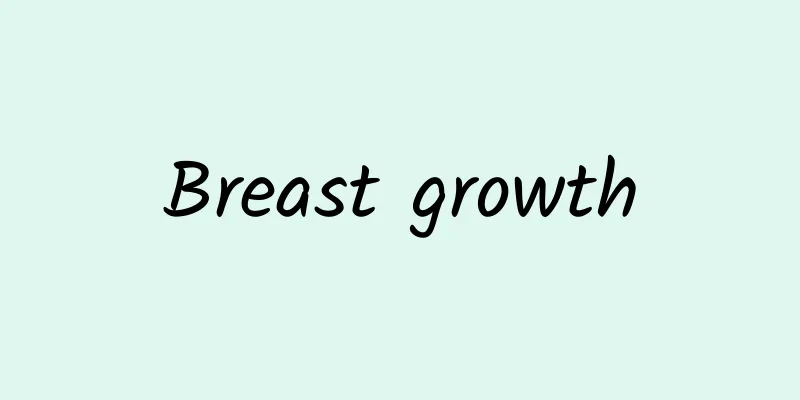Breast growth

|
Women's breasts are a part of the body that is prone to all kinds of problems. Some women accidentally find foreign objects in their breasts, such as hard lumps. Some of the lumps can slide back and forth when touched, and some lumps are accompanied by pain. At this time, many women will feel particularly panicked and wonder if they have a serious breast disease. So, what kind of breast disease might the things growing in the breasts be? 1. Causes and manifestations 1. Breast fibroadenoma Breast fibroadenoma is a mixed tumor of fibrous tissue and glandular epithelium occurring in the mammary lobule. The main clinical symptom of breast fibroids is painless breast lumps, which are rarely accompanied by breast pain and nipple discharge. Physical examination may reveal that the breast lump is oval or elliptical and has no obvious pain. The fibroid has a smooth surface, tough texture, clear boundaries, no adhesion to the skin and surrounding tissues, great mobility, and a sliding feel to the touch. Breast fibroma is generally caused by abnormally increased sensitivity of fibroblasts in the mammary lobules to estrogen, due to excessive stimulation of estrogen. This is benign and does not require treatment if it is small. Do not touch or stimulate it normally. Generally, after marriage and having a baby, the fibroma will resolve on its own through breastfeeding. 2. Breast hyperplasia Breast hyperplasia is relatively common among women, usually with breast lumps and no changes on the skin surface. Hyperplastic nodules of the breast are mostly caused by endocrine disorders. Hyperplastic nodules often present periodic pain with the menstrual cycle. The lumps can occur in one or both breasts, single or multiple, and generally occur in the upper outer quadrant of the breast. It appears as flakes, nodules, cords, etc. of varying sizes, among which flakes are the most common. The border is not obvious, the texture is medium or slightly hard, there is no adhesion to the surrounding tissues, and there is often tenderness. 3. Breast lobular hyperplasia Breast proliferative diseases are the most common non-tumor, non-inflammatory proliferative lesions. There are many causes of lobular hyperplasia of the breast, but most of them are closely related to endocrine disorders or mental emotions. The main clinical manifestations of lobular breast hyperplasia are: breast fullness and pain 5-7 days before menstruation, relief of breast pain during menstruation, or even disappearance, and cyclical changes occur again before the next menstruation. The lumps are often multiple and may be confined to one breast or diffuse to both breasts. The lumps are granular nodules, some as small as sesame seeds and some as large as clusters, but they lack obvious boundaries and have no adhesion to the skin and deep tissues. Patients often have varying degrees of breast pain, which is related to the menstrual cycle. The pain is more severe before menstruation and less severe after menstruation. 4. Breast cancer Breast cancer is a malignant tumor that occurs in the mammary gland epithelial tissue. Risk factors for breast cancer include early menarche and late menopause; being unmarried, childless, having children late in life, and not breastfeeding; not promptly diagnosing and treating benign breast diseases; having atypical breast hyperplasia confirmed by a hospital biopsy (tissue biopsy); high doses of radiation to the chest; long-term use of exogenous estrogen; postmenopausal obesity; long-term excessive drinking; and carrying a mutated gene associated with breast cancer. 80% of breast cancer patients first present with a breast lump. Patients often discover breast lumps accidentally, which are usually single, hard, with irregular edges and a less smooth surface. Most breast cancers are painless lumps, and only a few are accompanied by varying degrees of dull pain or tingling. 3. Notes 1. Don't stay up late often, ensure adequate sleep, avoid excessive fatigue and excitement, and stay in a good mood to prevent negative emotions from affecting the endocrine system and aggravating the condition. 2. Maintain a regular life, adjust your mood, relax, exercise regularly, and don't let yourself get too tired; keep your breasts clean, wash them frequently with warm water, and pay attention to changes in breast lumps. 4. Prevention Keep the breasts and the surrounding area clean, wear loose underwear, keep a good mood, eat a light diet, and avoid spicy, fried and other irritating foods; do not use exogenous estrogen indiscriminately; do not drink excessively for a long time. |
<<: Why do I often have breast pain?
>>: What to do if you have breast pain during lactation
Recommend
How does Traditional Chinese Medicine treat myopia?
With the continuous advancement of high technolog...
What to do if your child has bad breath due to indigestion
For young children, their intestinal development ...
What to do if you want to get pregnant but your estrogen level is low?
Estrogen is very important for women. If the horm...
Viral hepatitis symptoms
There are two organs in the human body that are r...
What are the contraindications of borneol?
Traditional Chinese medicine has a long history i...
What is simple nephrotic syndrome?
Kidneys, we know that they are very important. Ev...
Home remedies for psoriasis
People have been asking about folk remedies for t...
What medicine should I take if the phlegm is hard to cough up?
We all know that there is a tonsil in the human t...
How long does it usually take to take Chinese medicine to nourish the kidneys?
If the human body has kidney deficiency or insuff...
Dilated cardiomyopathy surgery
We all know that medicines are effective for gene...
What is the small pimple on the outside of my eyelid?
It is quite common to have a small pimple on the ...
What can be used with Tu Fuling to remove dampness?
Smilax glabra is the dried underground stem of th...
What is the reason for shaking hands and legs?
Everyone has some little habits in daily life. Fo...
What to do if you have scars on your arms
Scars are very unsightly, but most of them can be...
Precautions after lumbar spine reduction
When it comes to lumbar spine problems, many peop...









